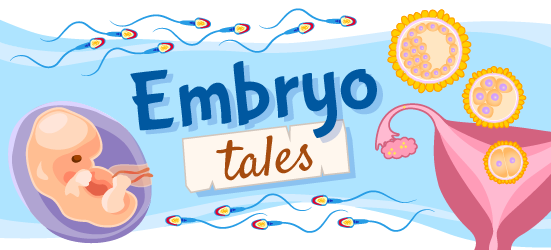
Twin Tales
Illustrated by: Sabine Deviche
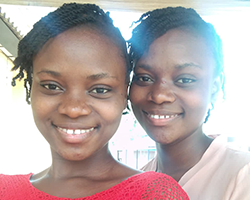
You are starting at a new middle school today. You take your seat and nervously look around the room. You don’t know anyone here – you left all your friends back home! As your new classmates trickle through the door, two girls step into the classroom. They look exactly the same.
Are you seeing double? You rub your eyes and look again. Nope, there are two girls. And they still look the same. How is that possible?
One of the girls makes a beeline for the corner of the room and plops down on a seat, staying quiet. Then, someone taps you on the shoulder. You turn around to see the other girl. She introduces herself as Jennah, and you two make fast friends.
Those two girls are an example of what are called identical twins. Twins are siblings who develop in the same womb at the same time. Although some twins can look pretty similar, they are not truly identical in all ways. For example, Jennah and Sana have their own personalities. Jennah is outgoing, and Sana is quiet. And as you start to spend more time with twins, you notice they look a little different, too. Jennah’s eyes are bigger, and Sana’s fingers are smaller.
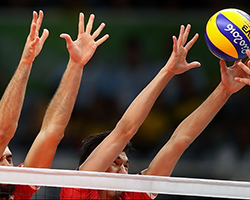
If Jennah and Sana are so different, why do they look identical? Let’s learn more about what it means to be a twin and how twins develop.
Double Development
Women usually give birth to just one infant. But sometimes, they give birth to more than one. If a woman gives birth to two infants at the same time, they are twins.
There are two main types of twins. One is identical twins, like Jennah and Sana, and the other is fraternal twins. Let’s learn more about each type.
Identifying Identicals
Identical twins develop from a single fertilized egg. Most often, a single fertilized egg will go on to develop into a single infant. But sometimes, the egg can split into two embryos during the first 12 days of pregnancy. Those two embryos have almost identical DNA. Because of that, they will grow into identical twins.

As identical twins share almost all their DNA, they are the same sex. This means that a mother who is pregnant with identical twins will give birth to either two male babies or two female babies.
Just like the two girls in your class, identical twins share similar features. They usually are about the same weight and height, and have similar hair color. But identical twins can differ, too. They each have unique fingerprints, though they are still fairly similar. Most of all, they can have really different personalities – just like Jennah and Sana!
Fraternal Focus

Fraternal twins tend to look fairly different from each other. They develop when two different egg cells each fuse with a different sperm. This results in two embryos that each have their own unique set of DNA. That is why fraternal twins look like siblings, rather than copies of each other.
They can also be different sexes. This means that a mother who is pregnant with fraternal twins can have one male and one female baby, or two females, or two males.
Developmental Dilemmas
Twins are more likely to face birth complications than infants born on their own. The most common complication is premature (or early) birth. When fetuses are born prematurely, parts of their bodies may not be as developed as they could be at birth. They might have issues breathing because of underdeveloped lungs or trouble gaining weight, for example. Around half of twins are born prematurely.
Connected Companions
Rarer complications can also occur as twins develop. In 0.00002% of all births, twins are born physically joined together. This condition is known as conjoined twins. The extent to which conjoined twins are attached varies, but most commonly, they are connected at the chest, stomach, or pelvis.
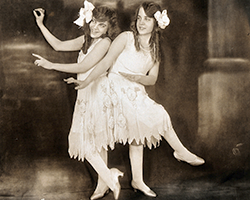
Why does this phenomenon occur? Sometimes during pregnancy, one embryo partially splits into two embryos. However, it fails to split all the way, so the embryos grow while physically connected. The result of this is identical twins who are physically stuck to each other.
If conjoined twins survive birth, doctors can often separate them with surgery. However, the success of the surgery depends on where the twins are connected. For example, it’s more difficult to separate twins who are connected at the head than twins who are connected on one side. That’s because the head has more complex organs that can be damaged when trying to separate twins.
The chances of conjoined twins living for long after birth is low. The survival rate is around 7.5% for conjoined twins who have to undergo surgery. But, this is a much better chance than before. Advances in science have helped increase twins’ chances of survival.
Twin Tales
Three months into school, you’ve become best friends with Jennah. Sana… not so much. She doesn’t seem to be interested in making friends.

Even though you are now used to how different they are, it still surprises you. How can they act so different when they look the same?
Scientists have been asking the same question for years. They wanted to know if, and how much, a person’s DNA determines their personality. Identical twins are perfect to study for this question, as they have the same DNA. So, their DNA cannot be the main reason that the twins have opposing personalities.
Nature vs. Nurture
In 1875, a scientist named Francis Galton studied twins. He wanted to find out whether heredity played a difference in how smart a person becomes. Many people at the time believed that children got their intelligence from their parents. But others argued that those parents gave their children better schooling. To look into where intelligence and other traits come from, Galton decided to study different types of twins.
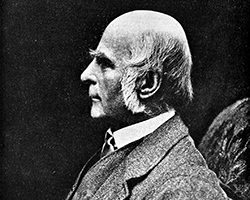
Galton reached out to as many pairs of twins as he could find to survey them. Most of the people who responded to his survey were identical twins. When Galton wrote his paper, he listed a few major findings. The first is that identical twins looked the same to most people around them. But, to their mothers and others who knew them well, there were certain facial expressions and mannerisms that told the twins apart. This meant that personality does not entirely come from DNA.
Galton also found that identical twins who grew up with each other stayed similar after they moved apart. Identical twins often suffered from the same diseases, even though they were far apart. They shared similar ideas, and made the same sorts of decisions.
Galton also noted that fraternal twins who grew up together didn’t become more similar to each other as time passed. They shared some similarities, like siblings do. But, as they became older, they continued to grow differently.
Galton’s work showed that nature, or inheritance, has an effect on people’s personalities. This led to his belief that nature (inheritance) has a greater effect than nurture (environment).
Nature vs Nurture: Who Wins?
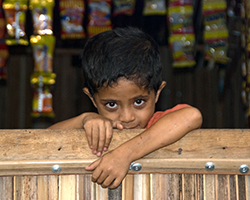
There is an ongoing debate about whether nature or nurture is the stronger force. Many studies have shown nature affects a person’s personality. But, the environment can affect the personality as well. If Jennah didn’t have anyone to talk to, she might learn to be less social. However, it’s hard to predict how she would change.
Whether nature or nurture is stronger depends on a few things. The trait in question is a big part of it. Some traits are much more heritable, like eye color, while others depend much more on environment, like weight.
Whether it’s because of nature or nurture, every person develops uniquely. No matter how identical twins might look, they are still their own person at the end of the day.
Image of Mark and Scott Kelly by NASA Johnson via Flickr.
This Embryo Tale was edited by Cole Nichols and is based on the following Embryo Project articles:
Bahjat, Mudhaffar, "“Sources of Human Psychological Differences: The Minnesota Study of Twins Reared Apart” (1990), by Thomas J. Bouchard Jr, David T. Lykken, Matthew McGue, Nancy L. Segal and Auke Tellegen". Embryo Project Encyclopedia (2017-10-19). ISSN: 1940-5030 http://embryo.asu.edu/handle/10776/12997.
Bahjat, Mudhaffar, "“The History of Twins, As a Criterion of the Relative Powers of Nature and Nurture” (1875), by Francis Galton". Embryo Project Encyclopedia (2017-12-19). ISSN: 1940-5030 http://embryo.asu.edu/handle/10776/13029.
DeRuiter, Corinne, "Multi-Fetal Pregnancy". Embryo Project Encyclopedia (2012-01-01). ISSN: 1940-5030 http://embryo.asu.edu/handle/10776/2288.
Lawrence, Cera R., "Francis Galton (1822-1911)". Embryo Project Encyclopedia (2011-04-06). ISSN: 1940-5030 http://embryo.asu.edu/handle/10776/1800.
External Sources:
“About Twins.” Twins Research Australia. (n.d.). Retrieved May 4, 2022, from https://www.twins.org.au/twins-and-families/about-twins.
Afzal, Ahmed R., & Montero, Freddy J. “Conjoined Twins.” National Library of Medicine (2021-08-14). Retrieved May 4, 2022, from https://www.ncbi.nlm.nih.gov/books/NBK560839/.
Chauhan, Suneet P., Scardo, James A., Hayes, Edward, Abuhamad, Alfred Z., & Berghella, Vincenzo (2010). Twins: prevalence, problems, and preterm births. American Journal of Obstetrics and Gynecology, 203(4), 305–315. https://doi.org/10.1016/j.ajog.2010.04.031.
The Children's Hospital of Philadelphia, “Conjoined twins.” Children's Hospital of Philadelphia (2014-03-26). Retrieved May 4, 2022, from https://www.chop.edu/conditions-diseases/conjoined-twins.
Read more about: Twin Tales
Bibliographic details:
- Article: Twin Tales
- Author(s): Tazeen Ulhaque, Whitney Alexandra Tuoti
- Publisher: Arizona State University School of Life Sciences Ask A Biologist
- Site name: ASU - Ask A Biologist
- Date published: 29 Aug, 2022
- Date accessed:
- Link: https://askabiologist.asu.edu/embryo-tales/twins-baby
APA Style
Tazeen Ulhaque, Whitney Alexandra Tuoti. (Mon, 08/29/2022 - 17:48). Twin Tales. ASU - Ask A Biologist. Retrieved from https://askabiologist.asu.edu/embryo-tales/twins-baby
Chicago Manual of Style
Tazeen Ulhaque, Whitney Alexandra Tuoti. "Twin Tales". ASU - Ask A Biologist. 29 Aug 2022. https://askabiologist.asu.edu/embryo-tales/twins-baby
Tazeen Ulhaque, Whitney Alexandra Tuoti. "Twin Tales". ASU - Ask A Biologist. 29 Aug 2022. ASU - Ask A Biologist, Web. https://askabiologist.asu.edu/embryo-tales/twins-baby
MLA 2017 Style

Mark and Scott Kelly are twin brothers who used to work as astronauts for NASA. Mark retired before Scott did, so NASA performed studies on the brothers. They found that the organs inside of Scott's body acted very differently in space from how Mark's organs acted on Earth.
Be Part of
Ask A Biologist
By volunteering, or simply sending us feedback on the site. Scientists, teachers, writers, illustrators, and translators are all important to the program. If you are interested in helping with the website we have a Volunteers page to get the process started.
